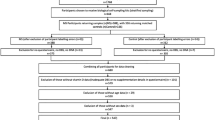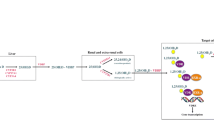Abstract
Risk of multiple sclerosis (MS) decreases with increasing plasma levels of 25-hydroxyvitamin D [25(OH)D]. If this association reflected a protective effect of vitamin D, MS risk should be lower among individuals carrying genetic variants that predict high 25(OH)D levels. The aim of the study was to determine whether individuals with genotypes predicting higher 25(OH)D levels have decreased MS risk. Logistic regression was used to assess the association between single nucleotide polymorphisms (SNPs) associated with 25(OH)D levels and MS risk in 1,655 cases and 6,349 controls. Analyses were further stratified by HLA-DR15 status, assessed by genotyping a single SNP strongly correlated with the HLA DRB1*1501 risk haplotype, and complemented by considering a SNP near CYP27B1. SNPs in GC were predictors of 25(OH)D levels, but not MS risk, in either HLA-DR15 negative or HLA-DR15 positive individuals. In contrast, there was a suggestion of a difference in the effect of a CYP2R1 allele dependent on HLA-DR15 genotype. The ‘A’ allele of CYP2R1 rs10741657 was associated with increased 25(OH)D levels and a non-significant reduced MS risk among HLA-DR15 negative (OR = 0.89, 95% CI: 0.79, 1.01) that was not apparent in HLA-DR15 positive individuals. The ‘C’ allele of CYP27B1 rs703842 was inversely associated with MS risk; this association appeared stronger among HLA-DR15 negative (OR = 0.79, 95% CI: 0.69, 0.90) compared to HLA-DR15 positive individuals (OR = 0.91, 95% CI: 0.80, 1.04). This preliminary finding suggests the possibility that the putative beneficial effect of vitamin D on MS risk maybe attenuated in individuals carrying the HLA-DR15 MS risk allele.
Similar content being viewed by others
References
Munger KL, Zhang SM, O’Reilly E, Hernán MA, Olek MJ, Willett WC, Ascherio A (2004) Vitamin D intake and incidence of multiple sclerosis. Neurology 62:60–65
Munger KL, Levin LI, Hollis BW, Howard NS, Ascherio A (2006) Serum 25-hydroxyvitamin D levels and risk of multiple sclerosis. J Am Med Assoc 296:2832–2838
Cantorna MT (2008) Vitamin D and multiple sclerosis: an update. Nutr Rev 66:S135–S138
Ascherio A, Munger KL (2007) Environmental risk factors for multiple sclerosis. Part II: noninfectious factors. Ann Neurol 61:504–513
Ramagopalan SV, Maugeri NJ, Handunnetthi L, Lincoln MR, Orton S, Dyment DA, DeLuca GC, Herrera BM, Chao MJ, Sadovnick AD, Ebers GC, Knight JC (2009) Expression of the multiple sclerosis-associated MHC class II allele HLA-DrB1*1501 is regulated by vitamin D. PLoS Genet 5:e1000369
Clayton D, McKeigue PM (2001) Epidemiological methods for studying genes and environmental factors in complex diseases. Lancet 358:1356–1360
Hunter DJ, Kraft P, Jacobs KB, Cox DG, Yeager M, Hankinson SE, Wacholder S, Wang Z, Welch R, Hutchinson A, Wang J, Yu K, Chatterjee N, Orr N, Willett WC, Colditz GA, Ziegler RG, Berg CD, Buys SS, McCarty CA, Feigelson HS, Calle EE, Thun MJ, Hayes RB, Tucker M, Gerhard DS, Fraumeni JF Jr, Hoover RN, Thomas G, Chanock SJ (2007) A genome-wide association study identifies alleles in FGFR2 associated with risk of sporadic postmenopausal breast cancer. Nat Genet 39:870–874
Bertone-Johnson ER, Chen WY, Holick MF, Hollis BW, Colditz GA, Willett WC, Hankinson SE (2005) Plasma 25-hydroxyvitamin D and 1, 25-dihydroxyvitamin D and risk of breast cancer. Cancer Epidemiol Biomarkers Prev 14:1991–1997
Ahn J, Stolzenberg-Solomon R, Simon K, McCullough M, Gallichio L, Jacobs E, Ascherio A, Helzlsouer K, Jacobs K, Li Q, Weinstein S, Purdue M, Virtamo J, Horst R, Wheeler W, Chanock S, Hunter D, Hayes R, Kraft P, Albanes D (2010) Genome-wide association study of circulating vitamin D levels. Hum Mol Genet 19:2739–2745
Han J, Kraft P, Nan H, Guo Q, Chen C, Qureshi A, Hankinson SE, Hu FB, Duffy DL, Zhao ZZ, Martin NG, Montgomery GW, Hayward NK, Thomas G, Hoover RN, Chanock S, Hunter DJ (2008) A genome-wide association study identifies novel alleles associated with hair color and skin pigmentation. PLoS Genet 4:e1000074
Huang L, Li Y, Singleton AB, Hardy JA, Abecasis G, Rosenberg NA, Scheet P (2009) Genotype-imputation accuracy across worldwide human populations. Am J Hum Genet 84:235–250
Kraft P, Cox DG, Paynter RA, Hunter D, De Vivo I (2005) Accounting for haplotype uncertainty in matched association studies: a comparison of simple and flexible techniques. Genet Epidemiol 28:261–272
Kraft P, Stram DO (2007) Re: the use of inferred haplotypes in downstream analysis. Am J Hum Genet 81:863–865
International Multiple Sclerosis Genetics Consortium, Hafler DA, Compston A, Sawcer S, Lander ES, Daly MJ, De Jager PL, de Bakker PI, Gabriel SB, Mirel DB, Ivinson AJ, Pericak-Vance MA, Gregory SG, Rioux JD, McCauley JL, Haines JL, Barcellos LF, Cree B, Oksenberg JR, Hauser SL (2007) Risk alleles for multiple sclerosis identified by a genome wide study. N Engl J Med 357:851–862
McDonald WI, Compston A, Edan G, Goodkin D, Hartung HP, Lublin FD, McFarland HF, Paty DW, Polman CH, Reingold SC, Sandberg-Wollheim M, Sibley W, Thompson A, van den Noort S, Weinshenker BY, Wolinsky JS (2001) Recommended diagnostic criteria for multiple sclerosis: guidelines from the International Panel on the diagnosis of multiple sclerosis. Ann Neurol 50:121–127
De Jager PL, Jia X, Wang J, de Bakker PI, Ottoboni L, Aggarwal NT, Piccio L, Raychaudhuri S, Tran D, Aubin C, Briskin R, Romano S, Baranzini SE, McCauley JL, Pericak-Vance MA, Haines JL, Gibson RA, Naeglin Y, Uitdehaag B, Matthews PM, Kappos L, Polman C, McArdle WL, Strachan DP, Evans D, Cross AH, Daly MJ, Compston A, Sawcer SJ, Weiner HL, Hauser SL, Hafler DA, Oksenberg JR (2009) Meta-analysis of genome scans and replication identify CD6, IRF8 and TNFRSF1A as new multiple sclerosis susceptibility loci. Nat Genet 41:776–782
The International HapMap Consortium The International HapMap Project (2003) Nature 426:789–796
The Australia New Zealand Multiple Sclerosis Genetics Consortium (ANZgene) (2009) Genome-wide association study identifies new multiple sclerosis susceptibility loci on chromosomes 12 and 20. Nat Genet 41:824–830
de Bakker PIW, McVean G, Sabeti PC, Miretti MM, Green T, Marchini J, Ke X, Monsuur AJ, Whittaker P, Delgado M, Morrison J, Richardson A, Walsh EC, Gao X, Galver L, Hart J, Hafler DA, Pericak-Vance M, Todd JA, Daly MJ, Trowsdale J, Wijmenga C, Vyse TJ, Beck S, Murray SS, Carrington M, Gregory S, Deloukas P, Rioux JD (2006) A high-resolution HLA and SNP haplotype map for disease association studies in the extended human MHC. Nat Genet 38:1166–1172
DerSimonian R, Laird N (1986) Meta-analysis in clinical trials. Control Clin Trials 7:177–188
Ahn J, Albanes D, Berndt SI, Peters U, Chatterjee N, Freedman ND, Abnet CC, Huang WY, Kibel AS, Crawford ED, Weinstein SJ, Chanock SJ, Schatzkin A, Hayes RB (2009) Vitamin D-related genes, serum vitamin D concentrations and prostate cancer risk. Carcinogenesis 30:769–776
Ramos-Lopez E, Bruck P, Jansen T, Herwig J, Badenhoop K (2007) CYP2R1 (vitamin D 25-hydroxylase) gene is associated with susceptibility to type 1 diabetes and vitamin D levels in Germans. Diabetes Metab Res Rev 23:631–636
Sundqvist E, Baarnhielm M, Alfredsson L, Hillert J, Olsson T, Kockum I (2010) Confirmation of association between multiple sclerosis and CYP27B1. Eur J Hum Genet 18:1349–1352
Cheng JB, Levine MA, Bell NH, Mangelsdorf DJ, Russell DW (2004) Genetic evidence that the human CYP2R1 enzyme is a key vitamin D 25-hydroxylase. Proc Natl Acad Sci USA 101:7711–7715
Daiger SP, Schanfield MS, Cavalli-Sforza LL (1975) Group-specific component (Gc) proteins bind vitamin D and 25-hydroxyvitamin D. Proc Natl Acad Sci USA 72:2076–2080
White P, Cooke N (2000) The multifunctional properties and characteristics of vitamin D-binding protein. Trends Endocrinol Metab 11:320–327
Steckley JL, Dyment DA, Sadovnick AD, Risch N, Hayes C, Ebers GC (2000) Genetic analysis of vitamin D related genes in Canadian multiple sclerosis patients. Canadian Collaborative Study Group. Neurology 54:729–732
Niino M, Kikuchi S, Fukazawa T, Yabe I, Tashiro K (2002) No association of vitamin D-binding protein gene polymorphisms in Japanese patients with MS. J Neuroimmunol 127:177–179
Arnaud J, Constans J (1993) Affinity differences for vitamin D metabolites associated with the genetic isoforms of the human serum carrier protein (DBP). Hum Genet 92:183–188
Wjst M, Altmuller J, Faus-Kessler T, Braig C, Bahnweg M, Andre E (2006) Asthma families show transmission disequilibrium of gene variants in the vitamin D metabolism and signalling pathway. Respir Res 7:60
Orton S, Morris AP, Herrera BM, Ramagopalan SV, Lincoln MR, Chao MJ, Vieth R, Sadovnick AD, Ebers GC (2008) Evidence for genetic regulation of vitamin D status in twins with multiple sclerosis. Am J Clin Nutr 88:441–447
Wang TJ, Zhang F, Richards JB, Kestenbaum B, van Meurs JB, Berry D, Kiel DP, Streeten EA, Ohlsson C, Koller DL, Peltonen L, Cooper JD, O’Reilly PF, Houston DK, Glazer NL, Vandenput L, Peacock M, Shi J, Rivadeneira F, McCarthy MI, Anneli P, de Boer IH, Mangino M, Kato B, Smyth DJ, Booth SL, Jacques PF, Burke GL, Goodarzi M, Cheung CL, Wolf M, Rice K, Goltzman D, Hidiroglou N, Ladouceur M, Wareham NJ, Hocking LJ, Hart D, Arden NK, Cooper C, Malik S, Fraser WD, Hartikainen AL, Zhai G, Macdonald HM, Forouhi NG, Loos RJ, Reid DM, Hakim A, Dennison E, Liu Y, Power C, Stevens HE, Jaana L, Vasan RS, Soranzo N, Bojunga J, Psaty BM, Lorentzon M, Foroud T, Harris TB, Hofman A, Jansson JO, Cauley JA, Uitterlinden AG, Gibson Q, Jarvelin MR, Karasik D, Siscovick DS, Econs MJ, Kritchevsky SB, Florez JC, Todd JA, Dupuis J, Hypponen E, Spector TD (2010) Common genetic determinants of vitamin D insufficiency: a genome-wide association study. Lancet 376:180–188
Tworoger SS, Lee IM, Buring JE, Rosner B, Hollis BW, Hankinson SE (2007) Plasma 25-hydroxyvitamin D and 1, 25-dihydroxyvitamin D and risk of incident ovarian cancer. Cancer Epidemiol Biomarkers Prev 16:783–788
Acknowledgments
The authors thank the International Multiple Sclerosis Genetics Consortium for the use of the genotype data for MS subjects. The work presented here is the sole content of the authors and does not necessarily represent the view of the National Institutes of Health. This work was funded by the National Institutes of Health/National Institute of Neurological Disorders and Stroke (R01 NS47467). Dr Simon was supported by a National Institute of Health/National Research Service Award grant (T32 ES016645-01).
Conflict of interest
None.
Author information
Authors and Affiliations
Corresponding author
Rights and permissions
About this article
Cite this article
Simon, K.C., Munger, K.L., Kraft, P. et al. Genetic predictors of 25-hydroxyvitamin D levels and risk of multiple sclerosis. J Neurol 258, 1676–1682 (2011). https://doi.org/10.1007/s00415-011-6001-5
Received:
Revised:
Accepted:
Published:
Issue Date:
DOI: https://doi.org/10.1007/s00415-011-6001-5




